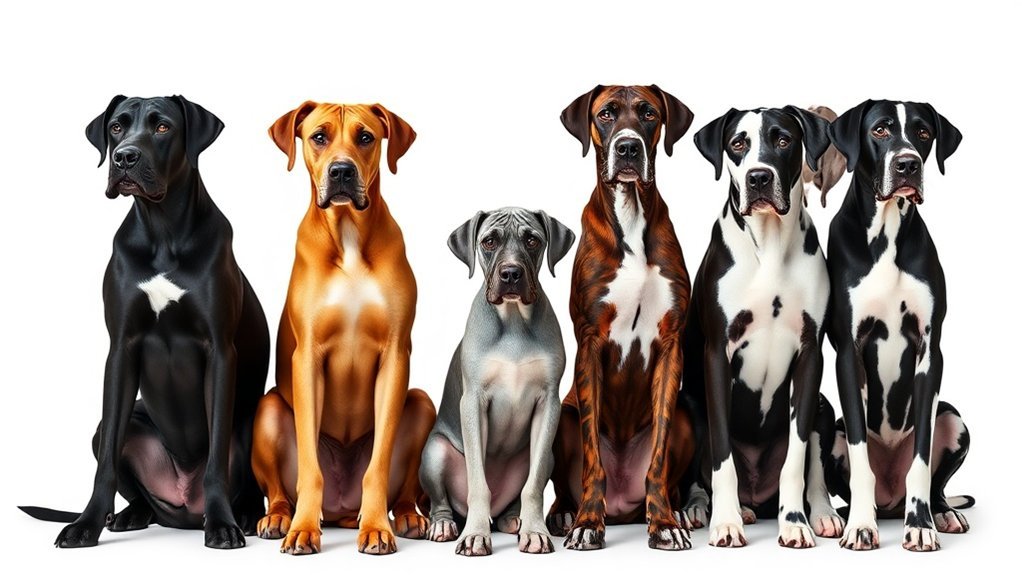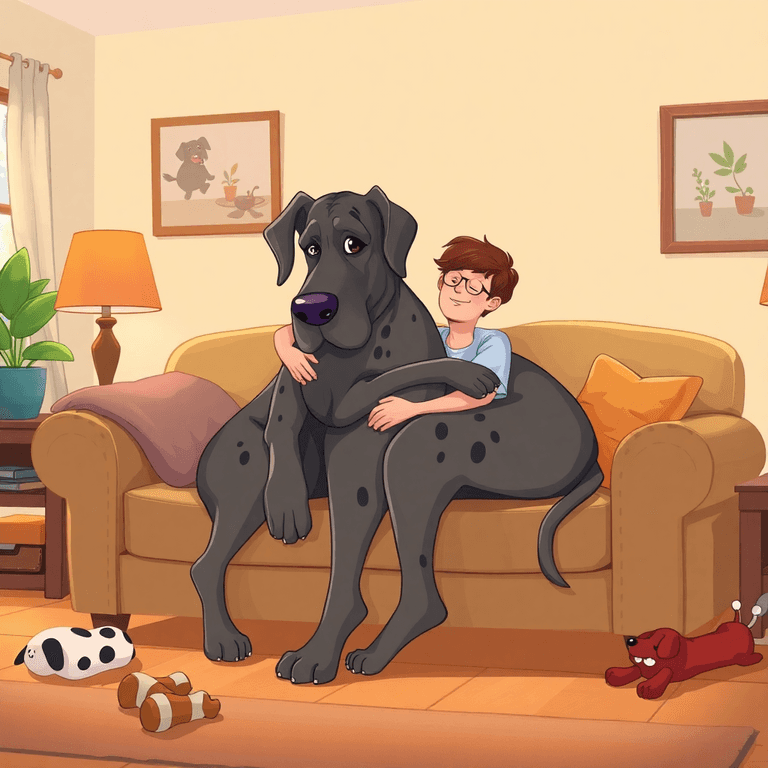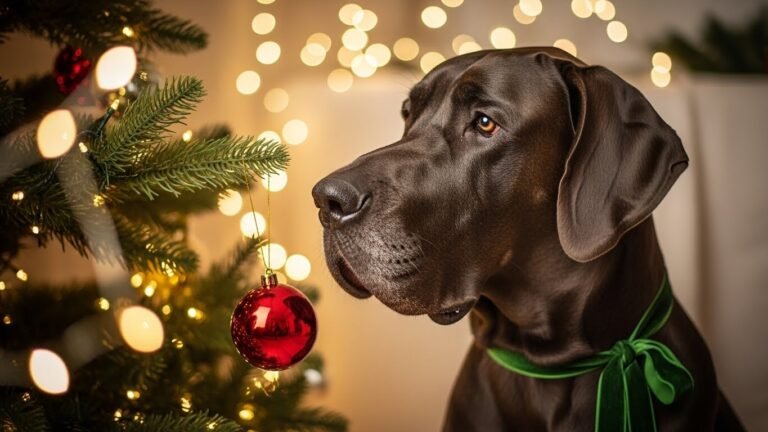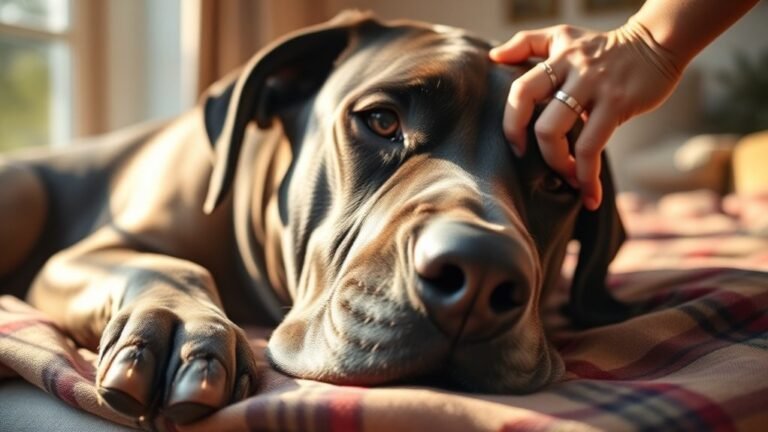Brindle: Basically my stripes are nature’s runway pattern
Great Dane Colors
Hey there, humans! It’s me, your friendly neighborhood Great Dane, here to tell you about all the fantastic colors we come in. Trust me, I know what I’m talking about – I see my doggy friends at the park every day!
According to the American Kennel Club, there are six official colors for Great Danes. First up is fawn – a beautiful, golden-yellow color with a cool, black mask around our faces. We look like superheroes! Then there’s brindle, which is characterized by golden fur with black stripes. My brindle buddy Yeti says he looks like a tiger, and honestly, he’s not wrong.
Blue Great Danes aren’t blue like the sky – we’re more of a pretty steel-gray color. I always tease my blue friend Daphne that she should be called “Gray Dane” instead! Pure black Great Danes, like Thor & Spicey Pumpkin, look super elegant and serious, as if they’re wearing fancy tuxedos all the time.
Now, harlequin like Zoe is really fun – these dogs are white with black patches scattered all over. They remind me of spotted cows, but don’t tell them I said that! Mantle colored dogs like me have black or blue bodies with white chest markings, kind of like we’re wearing fancy vests.
All these colors come from something called genetics – basically, it’s like a recipe our parents pass down to us that decides what we’ll look like. Some combinations can cause problems with vision or hearing, so smart breeders ensure they pick parents carefully.
It’s pretty cool how nature has made us all so different and beautiful, right? Now, if you’ll excuse me, I hear my food bowl calling!
Official AKC Recognized Great Dane Colors and Standards
Hey there, humans! It’s me, your friendly neighborhood Great Dane, and I’m here to tell you about all the fantastic ways we giant pups can look!
You know how you humans come in different colors? Well, we do too! The fancy dog show people – they call themselves the American Kennel Club – have decided there are six official ways a Great Dane like me can be colored. Let me break it down for you!
First up is Fawn. That’s basically golden yellow with a cool black mask on our face. I like to think it makes us look like superheroes!
Then there’s brindle, which is like someone took that same golden color and painted black stripes all over us. We’re basically walking tigers, but much friendlier!
Blue Great Danes aren’t blue like the sky – sorry to disappoint! We’re more like a steel-gray color. No fancy markings needed – we’re gorgeous just as we are.
Black Great Danes are pretty straightforward, too. We’re pure black, though some of us get lucky with a little white patch on our chest like a fancy bow tie.
Now here’s where it gets really cool! Harlequin Great Danes resemble someone who has spilled black paint on white paper in the most artistic way possible. We’ve got a white base with black splotches scattered all over our massive bodies.
And finally, there’s mantle – that’s black with white markings on our chest, neck, legs, and tail tip. We look dressed up for a formal dinner party!
All these different colors make sure us Great Danes keep looking awesome while staying true to what makes us, well, us! Proper training and socialization is key to ensuring we have the best temperament, no matter our color. Pretty neat, right?
Fawn and Brindle: The Golden Family Colors
My Golden Family: A Great Dane’s Guide to Fawn and Brindle Colors
Woof! Let me tell you about the most gorgeous colors in the Great Dane world – fawn and brindle. That’s right, we’re talking about my golden family! As a Great Dane who knows a thing or two about looking fabulous, I’m here to share the scoop on these warm, beautiful coat colors.
Both my fawn and brindle cousins have something super cool in common – we all rock that amazing golden-yellow base color. It’s like we’re all wearing fancy golden pajamas! The fawn Great Danes keep it simple and classy with their solid golden coats, which can be light and sunny or deep and rich, like honey.
We golden Great Danes are basically walking sunshine in fancy pajamas – classy, warm, and absolutely irresistible!
Me? I love how their color can change from pale gold (like a fresh tennis ball) to deep golden-yellow (like my favorite peanut butter treat).
Now, my brindle buddies are the show-offs of the family – and I mean that in the best way! They start with the same golden base but add these awesome black stripes that resemble chevrons or tiger stripes. It’s like someone took a paintbrush and made the coolest pattern ever right on their fur.
Here’s what makes us golden family members special:
Fawn Friends:
- Golden-yellow coat (solid color, no stripes)
- Must have a black mask (like a superhero!)
- No white markings allowed (sorry, no socks!)
Brindle Buddies:
- Same golden-yellow base as fawns
- Cool black striping pattern
- A black mask is required, too
- Can’t have too much white
Both fawn and brindle Great Danes need black ear leather and black eye rims to meet breed standards. Think of it as our natural eyeliner and ear polish – we’re always ready for our close-up!
The best part about being in the Golden family? We always look warm and friendly. People see our golden coats and immediately want to give us belly rubs.
And between you and me, that black mask makes us look mysterious and important – like we know all the neighborhood secrets (which we totally do). In addition to our stunning colors, it’s essential to maintain a balanced diet to support our health and well-being.
Black and Blue: Solid Coat Variations
Hey there, humans! Let me tell you about my black and blue Great Dane cousins – and no, we’re not talking about bruises from bumping into your coffee table (though that happens more than we’d like to admit when you’re this tall!).
First up are my sleek black buddies. These guys hit the genetic lottery in the simplest way possible. They got the “all black, all the time” genes without any of that fancy dilution stuff. Picture the shiniest, deepest black you’ve ever seen – that’s them! Their noses, lips, and even the inside of their mouths perfectly match their gorgeous coats. No white socks, no cute little chest patches – just pure, beautiful black from nose to tail tip.
Now, my blue friends are pretty special too. Don’t get confused, though – they’re not blue like a crayon! They’re more like a really cool steel gray or dark charcoal color. It’s like someone took the black coat and put a filter on it. This happens because of a gene called a dilution gene, which basically tells the black pigment, “Hey, chill out a little bit!”
Both the black and blue Great Danes require two copies of the “solid color” gene to exhibit this appearance. It’s like getting matching socks from both your mom and dad – you need both parents to pass down the correct genetic information. This is why we don’t have any white markings like some of our more colorful Great Dane family members. Understanding their coat colors is essential for both breeders and owners.
Harlequin, Mantle, and Merle: The Patterned Varieties
Harlequin, Mantle, and Merle: The Patterned Varieties
Woof! As a Great Dane who happens to rock a spectacular harlequin coat, let me tell you about the most astonishing coat patterns we dogs can have. Scientists call these “complex polygenic traits,” which is just a fancy way of saying our coats are like nature’s artwork, with many different genes working together.
My harlequin pattern originates from some impressive genetic teamwork. There’s a genetic trait called the H locus that pairs with merle genes to give me a white coat covered in black patches. It’s like someone splattered black paint on a white canvas – but way more artistic!
My mantle friends have a distinctive look, with their black or blue coats and white chest markings that give them a regal appearance, much like they’re wearing fancy tuxedos. Then there are the merle buddies with their marbled coats, which resemble someone mixing different colored clays. That cool effect comes from mutations in a gene called PMEL17, which affects the production of pigment patches in some individuals, making them lighter.
Here’s what makes each pattern special:
- Us harlequins need both merle genes and H-genes to get our spotted look
- Mantle dogs look like they borrowed their color scheme from Boston Terriers
- Merle creates those awesome mottled, swirled patterns
- Breeders have to be super careful with double-merle combinations because they can cause hearing and vision problems
- All our different colors come from modifier genes mixing and matching like ingredients in a recipe
In addition to our beautiful coats, Great Danes are known for their loyal nature, which makes us wonderful companions as well! Trust me, having a patterned coat means I get lots of compliments at the dog park. We’re basically walking art pieces with wagging tails!
Genetics and Breeding Considerations for Color Quality
So you want to know about genetics? Let me break it down for you in simple terms. You see, when my mom and dad decided to have puppies (that’s us Great Danes being all responsible about it), they each passed down special instructions called genes that decided what we’d look like.
Think of genes like a recipe book. Some recipes are really bossy – we call those “dominant” – and they always get their way. Others are more shy and only show up when there’s no bossy gene around – those are “recessive.” It’s kind of like when I’m trying to decide between my favorite tennis ball and that squeaky toy. The tennis ball usually wins because it’s more dominant in my mind!
Now here’s where it gets really cool – there’s this thing called the merle gene that makes some of us look like we got splattered with paint most beautifully. However, here’s the catch – if two merle parents have babies together, some of the puppies might be born with vision or hearing problems.
That’s why smart breeders (the good humans who help create more of us magnificent Great Danes) never put two merle parents together. It’s like mixing two strong medicines – sometimes, too much of a good thing can cause problems.
And don’t even get me started on harlequin patterns – those intricate black and white patterns on white backgrounds! Those require some really special gene combinations that are trickier than teaching me not to steal socks from the laundry basket. It’s all part of why assessing compatibility is so important for potential Great Dane owners.
The bottom line? Good breeders care more about ensuring we’re healthy and happy than just making us look pretty. Though let’s be honest – we Great Danes are pretty spectacular looking no matter what color we are!
Final Thoughts
Woof! Let me tell you about all the fantastic colors that Great Danes come in. Trust me, I’m an expert on this topic – I look at myself in the mirror every day!
First up, there’s fawn, which is basically a fancy way of saying golden-tan. Think of it like a perfectly toasted marshmallow, but way more handsome. Then we have brindle, which resembles someone taking a paintbrush and creating tiger stripes all over us. Pretty cool, right?
Now here’s where it gets really exciting – harlequin! That’s when we look like someone spilled black paint on a white canvas in the best possible way. We’re basically walking pieces of abstract art. Some of my Harlequin buddies think they’re pretty special, and honestly, they are.
Don’t forget about the solid black Great Danes who look like they’re ready for a fancy dinner party 24/7. They’re the formal wear of our breed. And then there are the blue ones, which aren’t blue like the sky, but more like a cool gray color. I know, humans are weird with color names.
The mantle pattern makes us look like we’re wearing superhero capes all the time. How awesome is that? We’re basically Superman but with four legs and a lot more drooling.
All these colors come from our parents’ genes, mixing like ingredients in a recipe. Sometimes you get chocolate chip cookies, sometimes you get oatmeal raisin – but we’re all delicious Great Danes in the end!
References
- https://greatdanecare.com/official-great-dane-colors/
- https://www.petworks.com/articles/great-dane-colors/
- https://www.doggenetics.co.uk/danes.htm
- https://greatdanecoffeecompany.com/blogs/drink-coffee-save-dogs/our-not-so-definitive-guide-to-great-dane-colors-coats
- https://images.akc.org/pdf/breeds/standards/GreatDane.pdf





